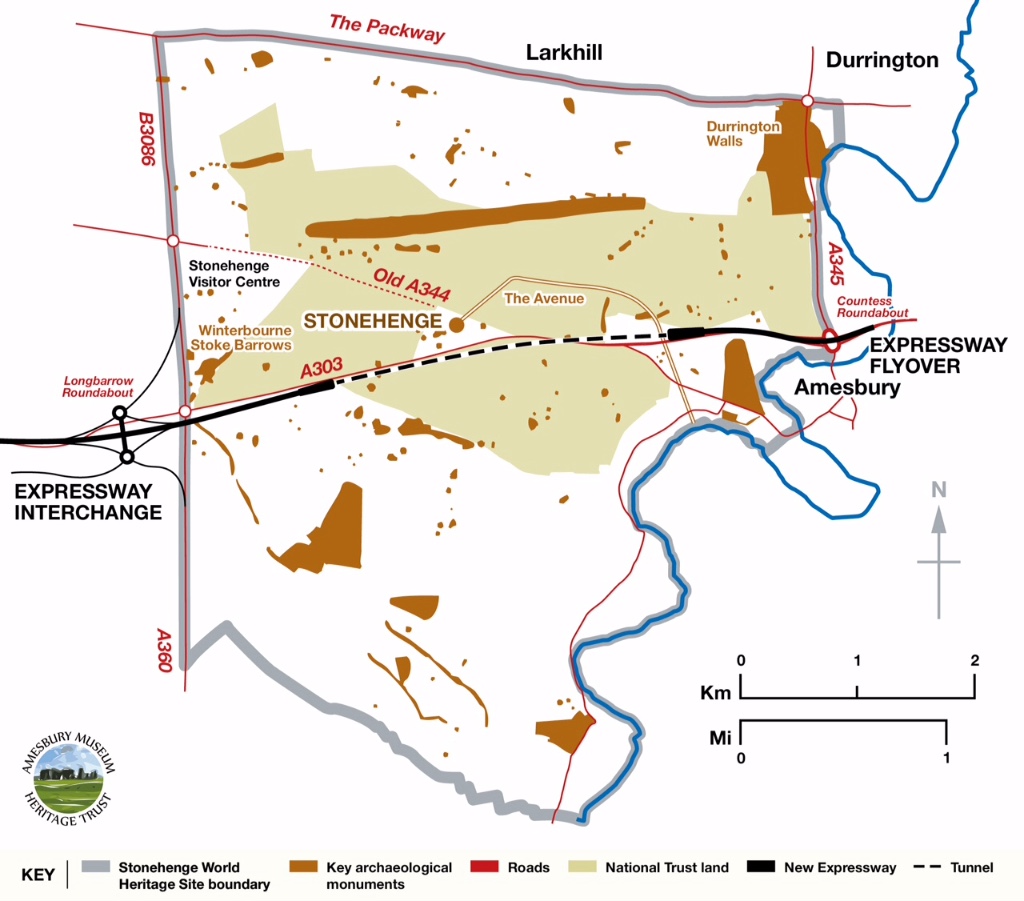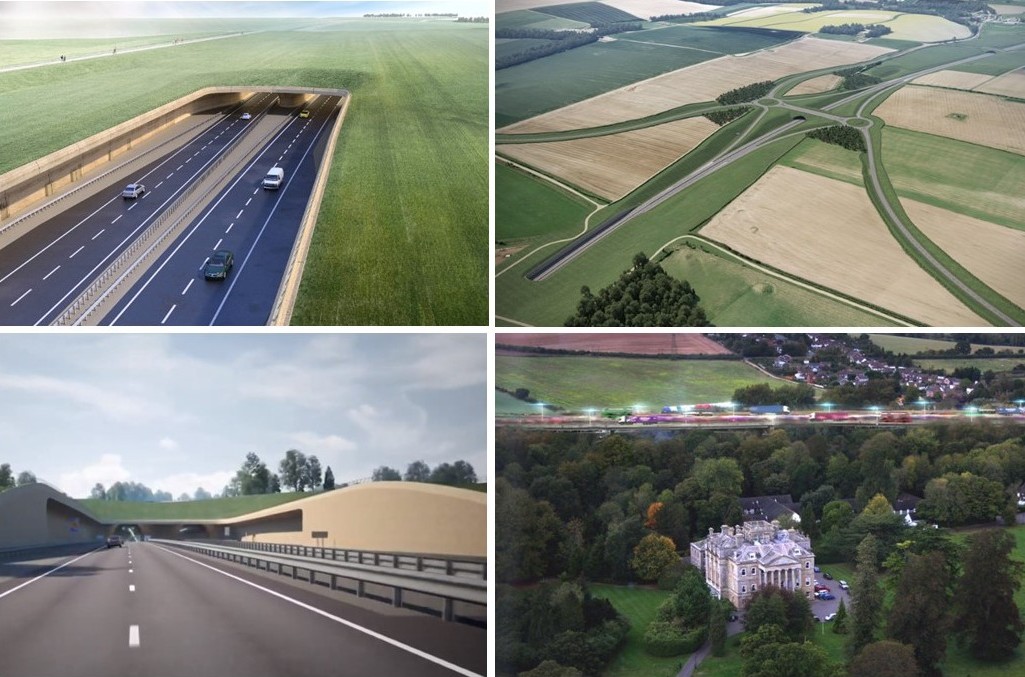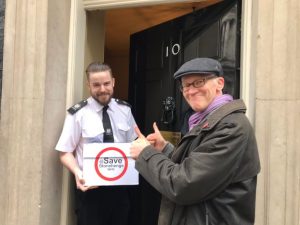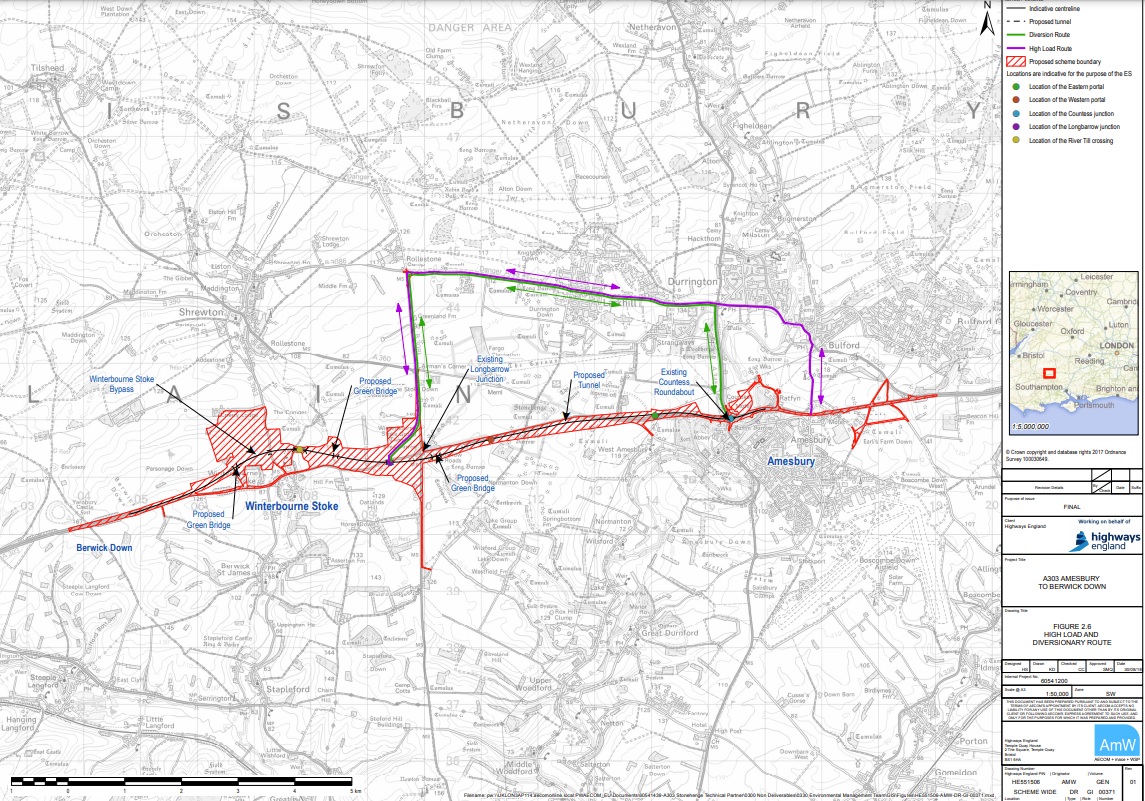Do you have a question? Please contact us on Twitter, Facebook or email us.
Updated October 2023
- Q1: What is wrong with a tunnel? Wouldn’t a tunnel be a great improvement for visitors?
- Q2. Why can’t Highways England widen the existing road?
- Q3. Passing motorists slow down to take photos of the Stonehenge monument. Would a hedge to screen the view on the A303 improve the flow of traffic?
- Q4. What are the alternatives to a c. 3km tunnel?
- Q5. How else would you spend £1.7bn on transport in the South West?
- Q6. How frequently is the tunnel at Hindhead closed?
- Q7. Following the quashing of the A303 Stonehenge scheme what happens next?
- Q8. What were the results of the consultations?
- Q9. Could not the Stonehenge bypass go north of Larkhill?
- Q10. What will happen when the tunnel is closed?
- Q11. Why do you not have a petition on the UK Parliament site?
Q1. What is wrong with a tunnel by Stonehenge? Wouldn’t a tunnel be a great improvement for visitors?
The road and tunnel are being sold on a false premise: that they would enhance “Stonehenge” and the “World Heritage Site”. The triangular field, where the stone monument stands is one part a vast prehistoric landscape.
The Government proposes to widen the A303 trunk road to the south west. The 4-lane carriageway, twin-bored tunnels, tunnel, slip roads and deep cuttings would cross the iconic Stonehenge WHS: a landscape that is considered “the most archaeologically significant land surface without parallel”. The whole Stonehenge landscape has an outstanding universal value that is of immense significance for all people for all time, and this transcends any consideration of sorting out a 21st century part-time traffic jam.
The tunnel is too short: It is c.3km across a c.5km World Heritage Site. Whilst It improves the view from the stone monument the Expressway would cause a significant gash to the east and west of the WHS.

The road and tunnel are being sold on a false premise: that they would enhance “Stonehenge” and the “World Heritage Site”. The triangular field where the stone monument stands is one part a vast prehistoric landscape. Read more.

The whole site, extending well beyond the horizons around the famous stones themselves, is c. 5.4 km across. All of it makes up a “huge ancient complex” that holds many secrets yet to be discovered. Yet the proposal is for a c. 3km (1.9 mile) tunnel (see map above). It would result in at least 2.4km of above-ground 21st-century road engineering within the WHS. The tunnel entrances
All archaeology in the construction zones would be destroyed and the A303 would become the largest ever human intervention in an area fashioned and revered by many hundreds of generations of our ancestors. It would cause irreparable damage to the WHS in breach of the UNESCO World Heritage Convention and ignores UNESCO’s firm advice in 2018 and 2019.
Our case against Highways England’s A303 Stonehenge scheme is here.
The World Heritage Committee in 2021 decided to consider placing the WHS on the list of World Heritage in Danger if the scheme proceeds in its present form.

Q2. Why can’t Highways England widen the existing road?
Neither surface dualling nor a short tunnel would meet the Government’s commitments under the World Heritage Convention, notably Article 4. Furthermore, the concept that congestion will be relieved by increasing road capacity is out of tune with the evidence and the mythical driver for this scheme. Evidence shows that such benefits are often not realised in practice.
You can read our two statements about issues concerning potential solutions for the A303 at Stonehenge and our position statement about the A303 expansion at Stonehenge.
ALSO: please see CPRE’s video about road building: End of the Road? Challenging the Road Building Consensus.
Q3. Passing motorists slow down to take photos of the Stonehenge monument. Would a hedge to screen the view on the A303 improve the flow of traffic?
Yes. But it would not hide the henge from the road at King Barrow Ridge where you get the first uplifting glimpse of the Stones from the east: people would still try to stop to look and photograph the view. On the other hand the famous view could merit a slowing down of traffic and a decision taken to actively manage a slower speed across this section.
Q4. What are the alternatives to a c. 3km tunnel?
Our position is that no further damage should be done to the archaeological landscaper of Stonehenge. Future generations would be appalled at those who decided that road widening should be at the expense of England’s most iconic World Heritage Site. If Government insists on a tunnel under the WHS, it should be done by means of a deep bored tunnel long enough to avoid the WHS and its setting altogether, or another route as suggested by UNESCO’s World Heritage Committee. This would be in line with planning policy and World Heritage Convention safeguards. In view of the Climate Emergency low cost, low carbon traffic management measures should be considered and tested straightaway. Traffic increase is a national problem that requires a national policy of traffic reduction. The current proposal for a Stonehenge tunnel should not be allowed to become an emblem for a failed transport policy.
Q5. How else would you spend £1.7bn on transport in the South West?
The poor economic case for the road shows it would cost far more to build than it would ever recoup in economic benefit and that’s before you factor in the huge risk of tunnelling through unstable phosphatic chalk, which could send costs skywards.
Highways England admits that the £1.7bn investment represents low to poor value. Inflation in construction is likely to drive costs up to £2.5bn and the National Audit Office considered the scheme a risky proposition.
Perhaps Government would do better to invest this money in upgrading the track and rail frequency to the South West. Alternatively invest in public services including public transport, building hospitals, schools, and mending potholes.
We reacted here to the Chancellor’s last announcement to fund the scheme on 11 March 2020. It was subsequently removed from the current roads programme. If the scheme passes future decision making hurdles the budget is expected to be carried forward by a future chancellor.
Q6. How frequently is the tunnel at Hindhead closed?
Highways England sent us reports on tunnel closures following a FOI Act. These reports covered the first years of operation from 2011 to 2017, summarised in the graph attached. The peak of closures between 2011 and 2015 was in August, followed by May and October/November.
The data was of insufficient quality to analyse the proportion of planned and unplanned closures between 2015 to 2017.
Alternative route shown in purple and green to be used when the tunnel is closed or for extra large vehicles. The red hatching is construction zone.
Q7. Following the quashing of the A303 Stonehenge scheme, what happens next?
The Secretary of State for Transport did not appeal the judgment handed down on 30 July 2021 but decided on an iterative process to ‘redetermine’ the same scheme. This process was kicked off with a Statement of Matters put to the Applicant (I.e. National Highways). NH’s replies were then consulted on. The consultees’ responses raised further questions, and the SoS put these to the Applicant which were also consulted on. Those responses were published on 25 August 2022. We await a final decision. The project overview with links to all the official stages can be viewed on the Planning Inspectorate’s A303 Stonehenge project website.
Q8. What were the results of the Statutory Consultations?
Highways England reported the results of the 2018 consultations here in upbeat terms. A large proportion of the respondents was the result of action taken by the Alliance and its supporter, FoE, as can be seen by the summary below of the ‘over 9,000’ responses:
| Response format | Number of responses received |
| Questionnaire responses via the consultation webpage | 2,547 |
| Questionnaire responses received by hand or by Freepost | 956 |
| Emails and letters | 111 |
| Emails using Stonehenge Alliance proforma | 1,686 |
| Emails using Friends of the Earth proforma | 3,943 |
| Total | 9,243 |
Whilst Highways England reported that people generally agreed that something should be done to address the problems on the A303 this was in the main in terms of traffic, not in terms of the benefit to Stonehenge.
There were several opportunities to register objections:
- A non-statutory consultation in 2017
- A statutory consultation in Spring 2018
- A supplementary consultation in Summer 2018
- Relevant Representations to the Planning Inspectorate in 2019
Our analysis shows an overwhelming number of objections were received by Highways England. 79% strongly opposed or opposed the scheme. A breakdown of these various opportunities is analysed below.
| Non-statutory, 2017 | Statutory, Feb-April 2018 | Supplementary, July-Aug 2018 | Inspectorate’s Relevant Representations, 2019 | |
| Online, web | 2547 | 1412 | 338 | |
| Form by post | 956 | 16 | ||
| Letter, email | 111 | 346 | 223 | |
| Stonehenge A proforma | 1686 | 3220 | 2170 | |
| FoE proforma | 3943 | 0 | ||
| Action Network proforma | 0 | 708 | ||
| FoE petition | 5067 | |||
| Inspectorate’s Relevant Representations | 2370 | |||
| Total | 9243 | 10045 | 3455 | 2370 |
| Total all | 25113 | |||
Our petition against the scheme currently stands at 51,365 (16 March 2020).
Q9. Could not the Stonehenge bypass go north of Larkhill?
No. The Ministry of Defence own the land and have set their face against it.
Q10. What will happen when the tunnel is closed?
One or other of the tunnels will be closed on a regular basis for overnight maintenance, with two-way traffic using the open tunnel. The route for high vehicles which cannot use the tunnels would be from the new Longbarrow Junction, north on the A360 and B3086, then east on The Packway and A3028, and south on Salisbury Road to Solstice Park and vice versa. In the event of emergency closure of both tunnels, traffic would be diverted along the high load route, but using the A345 (Countess Road) rather than the A3028 to re-join the A303 at Countess Roundabout. It is thought closure of both bores would be rare.
Q11. Why do you not have a petition on the UK Parliament site?
 1. Our petition has already made waves. For example a Westminster MP debate was held in June 2018.
1. Our petition has already made waves. For example a Westminster MP debate was held in June 2018.
2. We subsequently handed in our first batch of petition signatures to the Prime Minister and provoked correspondence between ministers and ourselves.
3. Parliamentary petitions are for UK citizens and residents only. After six months they expire. Our petition has to be part of a long term campaign for world wide citizen action and has run since 2014 when the scheme was first announced.
4. Petitioners who sign our petition can keep in touch, share their concerns with their MP and ask them to raise these with the Secretary of State concerned. If abroad, they can ask the British Ambassador to do likewise, as could the Culture Secretary of their country who could contact their UNESCO World Heritage representative for instance.
Do you have a question? Please contact us on Twitter, Facebook or email us. We will reply as soon as possible within our volunteer capacity!
REFERENCES
Highways England’s public consultation booklet public consultation booklet explains the plans for an A303 Stonehenge c3km tunnel, junctions and a bypass for Winterbourne Stoke.
More useful references in our library.
Please share

